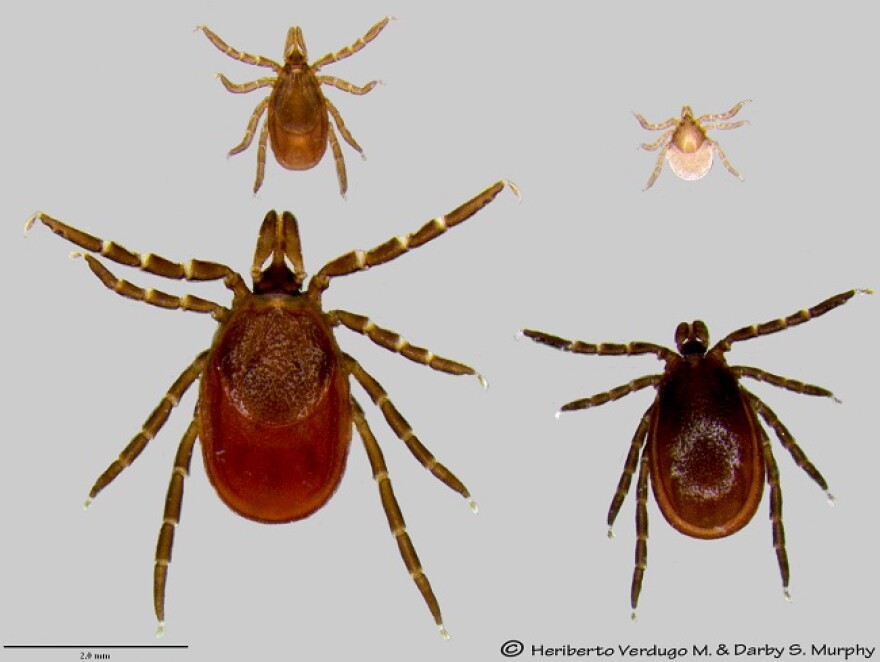Public health officials are urging Wisconsin residents to protect themselves and their families from potentially dangerous tick and mosquito bites, as insect-borne illnesses are on the rise nationally.
Diseases spread by insects, such as West Nile virus and Lyme disease, can have harmful effects on humans and animals.
Mosquito-borne Virus
Last week a dead crow found in Milwaukee County tested positive for West Nile virus.
“The positive bird means that residents of the North Shore and the region need to be more vigilant in their personal protective measures to prevent mosquito bites,” says Ann Christiansen, North Shore Health department director.

The cycle starts with a dead animal, such as the crow picked up and tested last week in Milwaukee County.
“Mosquitoes can bite birds and then in turn acquire the virus and then transfer it back to humans,” Christiansen adds. “When mosquitoes bite humans they don’t acquire West Nile. Birds are the ones that transmit the virus from mosquito to mosquito.”
The infectious disease first appeared in the southern United States in 1999, slowly finding its way to the northern regions. Christiansen says West Nile is now "really all over."
In 2001, the Wisconsin Department of Health Services started monitoring birds, horses, mosquitoes and humans. A year later the department confirmed the first human infection.
Last year 51 cases were documented in Wisconsin. “But one thing to note when I look back at our information from last year, this is a little earlier where we’re seeing our first bird testing positive. Previous years we reported in August or as late as September,” Christiansen says.
But the last thing she wants to do is raise undo alarm.
The majority of people — about 80 percent — bitten by West-Nile-Virus carrying mosquitoes will not get sick. Close to 20 percent might experience symptoms including fever, headache, muscle ache, rash and fatigue. But Christiansen says it’s the remaining vulnerable 1 percent (the elderly or those with compromised immune systems) for whom the virus can be life-threatening.
To be on the safest side before heading outdoors, Christiansen encourages people to apply insect repellent, such as DEET, or you can take a more “natural” approach.
“Oil of lemon eucalyptus is a repellent that’s been shown to be effective. So there are more options. But if people aren’t interested in that, wearing a long-sleeved shirt, long pants, just covering up so that the mosquitoes aren’t able to get through the clothing is a reasonable strategy,” she says.
As for reducing mosquitoes lurking close to home, Christiansen advises people to make sure window screens are in good shape. You can also avoid the unintentional breeding of mosquitoes by emptying water in wheelbarrows and wading pools.
For more information about preventing mosquito bites, view the Centers for Disease Control reccommendations.
Tick-borne Disease
Earlier this month the Wisconsin Department of Health Services announced the first documented death from Rocky Mountain spotted fever in the state, which was caused by the American dog tick.
But in Wisconsin most tick-borne disease is spread by the blacklegged or deer tick.
Milwaukee Public Museum’s Head of Zoology Jennifer Zaspel says the tick presents a growing public health issue and "is our Lyme Disease vector.”
Lyme disease is caused by bacterium transmitted to humans through the bite of infected blacklegged ticks. Symptoms can include fever and headaches. If not treated, infection can spread to joints, the heart and the nervous system.
“If you find a tick on you, toss it in the freezer in a [zip-close] bag and that way it can be tested later, especially if you find yourself showing symptoms.”
Ticks are stealthy creatures, although they can’t fly, “They’ve really become perfect at sensing their host in the environment. They’re able to smell you and sense temperature changes," Zaspel explains. "Some ticks hang out on blades of grass perfectly poised just waiting for that host to walk by and land on it.”
She suggests arming yourself with knowledge.
“Get online. There are some really excellent resources out there. The Russell labs at UW-Madison have a fantastic website with identification tools,” Zaspel adds. “If you find a tick on you, toss it in the freezer in a [zip-close] bag and that way it can be tested later, especially if you find yourself showing symptoms.”
Zaspel and her team are collaborating with fellow scientists both in-state and around the country to digitize and share tick collections’ data.
“I think as the data and specimens come in, I think we’ll see more possibilities for control options in the future,” she says.
Read: Help Researchers Analyze How People Contract Lyme Disease With Smartphone App
But until research results in a biological control or perhaps a vaccination, Zaspel recommends the kind of common sense precautions her own family – human and canine.
After hiking or other outdoor activities, she suggests taking a shower because it can be easier to feel the scalp when hair is wet.
"Help each other do those checks. And certainly let the dogs go for a swim too, so we can really feel whether or not they have anything,” Zaspel says. “Even in the winter months, we make sure our pets have preventative medications against fleas and ticks."
For more information about preventing tick bites, see the Centers for Disease Control recommendations.
Have an environmental question you'd like WUWM's Susan Bence to investigate? Submit below.
_







